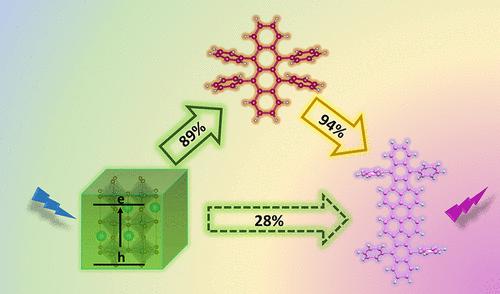当前位置:
X-MOL 学术
›
ACS Photonics
›
论文详情
Our official English website, www.x-mol.net, welcomes your feedback! (Note: you will need to create a separate account there.)
Energy Cascade in Halide Perovskite-Multiple Chromophore Films: Direct versus Mediated Transfer
ACS Photonics ( IF 7 ) Pub Date : 2024-03-20 , DOI: 10.1021/acsphotonics.4c00354 Jishnudas Chakkamalayath 1, 2 , Lauren E. Martin 1, 2 , Prashant V. Kamat 1, 2, 3
ACS Photonics ( IF 7 ) Pub Date : 2024-03-20 , DOI: 10.1021/acsphotonics.4c00354 Jishnudas Chakkamalayath 1, 2 , Lauren E. Martin 1, 2 , Prashant V. Kamat 1, 2, 3
Affiliation

|
The capability of halide perovskite nanocrystals to sensitize both singlet and triplet excited states of a chromophore highlights their potential as photosensitizers in down conversion (singlet energy transfer) or upconversion (triplet energy transfer followed by triplet–triplet annihilation) applications. In semiconductor-multiple chromophore assemblies, however, various possibilities arise to modulate the energy transfer process and hence the final emission output. By employing CsPbBr3 nanocrystals (Eg = 2.47 eV) as a primary sensitizer, we have now probed the singlet energy transfer to two dyes, viz., rubrene (Es = 2.23 eV) and DBP, a perylene derivative (Es = 2.07 eV). By first characterizing the excited-state interactions between CsPbBr3 and individual dye pairs, we establish the favorable pathway for singlet energy transfer in a donor–acceptor1–acceptor2 assembly. The singlet energy transfer efficiencies for CsPbBr3-rubrene, rubrene-DBP, and CsPbBr3-DBP systems were quantified as 89%, 94%, and 28%, respectively. When all three components (CsPbBr3-rubrene-DBP) are present in the film, we observe a cascading energy transfer to yield a high population of singlet excited-states in DBP. The 1DBP* yield increased with rubrene concentration, thus confirming its mediating role in the energy cascade. Thus, a proper choice of mediator can promote singlet energy transfer when the spectral overlap between a donor and acceptor is poor. Elucidation of the excited-state interactions in CsPbBr3-rubrene DBP films offers new insights into the sensitization of multiple chromophore assemblies and ways to modulate the singlet energy flow.
中文翻译:

卤化物钙钛矿多发色团薄膜中的能量级联:直接转移与介导转移
卤化物钙钛矿纳米晶体敏化发色团的单重态和三重态激发态的能力凸显了它们作为下转换(单重态能量转移)或上转换(三重态能量转移随后三重态-三重态湮灭)应用中的光敏剂的潜力。然而,在半导体多发色团组件中,出现了调节能量转移过程以及最终发射输出的各种可能性。通过使用 CsPbBr 3纳米晶体 ( E g = 2.47 eV) 作为主要敏化剂,我们现在已经探讨了向两种染料的单线态能量转移,即红荧烯 ( E s = 2.23 eV) 和 DBP,一种苝衍生物 ( E s = 2.07 eV)。通过首先表征 CsPbBr 3和单个染料对之间的激发态相互作用,我们建立了供体 - 受体1 - 受体2组装中单线态能量转移的有利途径。 CsPbBr 3 -红荧烯、红荧烯-DBP和CsPbBr 3 -DBP体系的单线态能量转移效率分别被量化为89%、94%和28%。当所有三种成分(CsPbBr 3 -红荧烯-DBP)都存在于薄膜中时,我们观察到级联能量转移,从而在 DBP 中产生大量单线态激发态。1 DBP * 产量随着红荧烯浓度的增加而增加,从而证实了其在能量级联中的调节作用。因此,当供体和受体之间的光谱重叠较差时,适当选择介体可以促进单线态能量转移。 CsPbBr 3 -红荧烯 DBP 薄膜中激发态相互作用的阐明为多个发色团组装体的敏化以及调节单线态能量流的方法提供了新的见解。
更新日期:2024-03-20
中文翻译:

卤化物钙钛矿多发色团薄膜中的能量级联:直接转移与介导转移
卤化物钙钛矿纳米晶体敏化发色团的单重态和三重态激发态的能力凸显了它们作为下转换(单重态能量转移)或上转换(三重态能量转移随后三重态-三重态湮灭)应用中的光敏剂的潜力。然而,在半导体多发色团组件中,出现了调节能量转移过程以及最终发射输出的各种可能性。通过使用 CsPbBr 3纳米晶体 ( E g = 2.47 eV) 作为主要敏化剂,我们现在已经探讨了向两种染料的单线态能量转移,即红荧烯 ( E s = 2.23 eV) 和 DBP,一种苝衍生物 ( E s = 2.07 eV)。通过首先表征 CsPbBr 3和单个染料对之间的激发态相互作用,我们建立了供体 - 受体1 - 受体2组装中单线态能量转移的有利途径。 CsPbBr 3 -红荧烯、红荧烯-DBP和CsPbBr 3 -DBP体系的单线态能量转移效率分别被量化为89%、94%和28%。当所有三种成分(CsPbBr 3 -红荧烯-DBP)都存在于薄膜中时,我们观察到级联能量转移,从而在 DBP 中产生大量单线态激发态。1 DBP * 产量随着红荧烯浓度的增加而增加,从而证实了其在能量级联中的调节作用。因此,当供体和受体之间的光谱重叠较差时,适当选择介体可以促进单线态能量转移。 CsPbBr 3 -红荧烯 DBP 薄膜中激发态相互作用的阐明为多个发色团组装体的敏化以及调节单线态能量流的方法提供了新的见解。



























 京公网安备 11010802027423号
京公网安备 11010802027423号